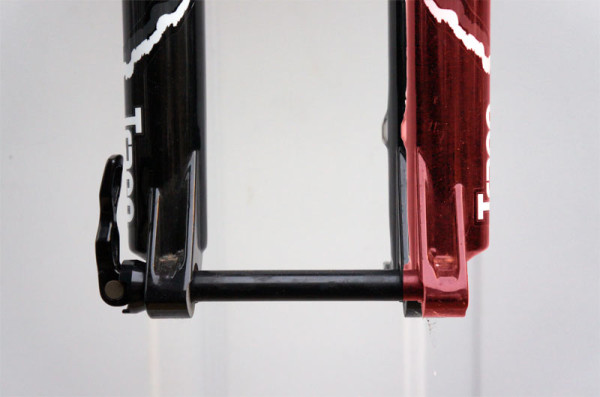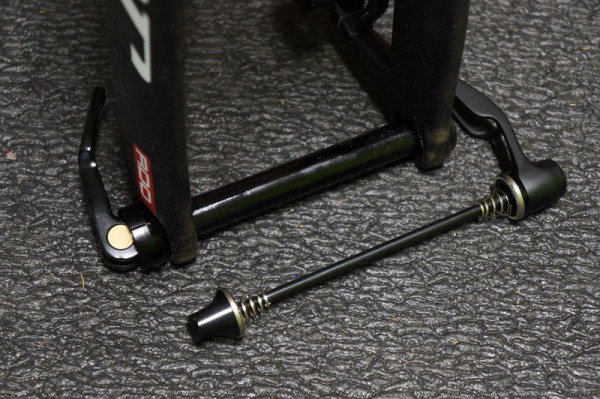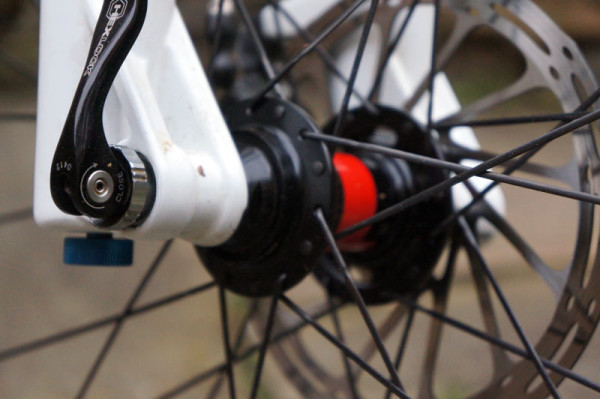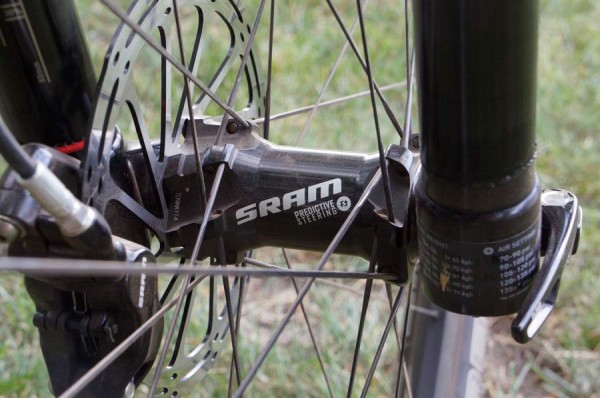Alongside the changes coming to rear wheels with the new Boost 148 standard, two new options will be offered up front in 2016: 15×110 for mountain bikes and 12×100 for road and cyclocross.
Starting with the new MTB standard, the goal here is much simpler. Where Boost 148 allows for a wide array of geometry and suspension benefits on top of the stiffer wheel platform, the front has just two missions: : Stiffer wheels and better tire clearance.
The current hub standard for mountain bikes is 100mm wide, so going to 110mm is a bigger overall change than the 6mm change in the rear. Presumably, that’ll benefit front wheel stiffness even more.
“15×110 can be taken almost as a parallel to the 148, it’s like Boost Front,” says Mike Gann, Niner’s COO. “If people are paranoid about wheel deflection and wheel stiffness, it’s going to make a larger format wheel (read: 29ers) feel different. And it seems like it’s really going to be pursued by a good chunk of the industry.”
The change also opens up tire clearance by about 0.4 inches. That’s the difference between shoehorning a 2.5 or almost a full 3.0 tire in the fork. That 3.0 figure, coincidentally, seems to be the poster boy for the upcoming “plus” sized wave of bikes, made much more possible thanks to these new axle standards…

Wheel stiffness will increase thanks to the wider hub base allowing for wider flange spacing, which increases the spoke angle triangulation with the rim. The graphic above shows just how much more room there’ll be by adding 10mm (click to enlarge for a better approximation of what 10mm looks like).
Norco’s marketing manager Chris Cook says “15×110 will make stiffer wheels and the see the rider benefit from improved control and handling. This is in consideration to be applied on a new hardtail model. Current spec for full suspension bikes is still 15×100.”
And Industry Nine, who already has 148 rear hubs on the market, says “We do have intentions to have 15×110 when the industry as a whole is ready to release those forks.”
We reached out to several major suspension manufacturers since you’ll need a new fork to fit the wider wheel, but none were ready to comment on the record. From our conversations with a lot of other folks, though, we’d say springtime should have plenty of announcements.
At this point, we’d be remiss if we didn’t give a nod to SRAM for quietly introducing the 110mm width to XC-level forks with the new RS-1 fork. Sure, 20mm thru axles have used 110mm spacing for years. And sure, it needs their special 27mm “Torque Tube” internal axle, but it’s almost as if they knew what was coming (and yes, that’s tongue in cheek…they absolutely knew what was coming). Considering everyone will be remaking their hubs to fit the new 15×110 standard, perhaps some will take the opportunity to build in compatibility with the RS-1 and increase wheel options usable with this inverted super fork. DT Swiss and American Classic already have RS-1 hubs in the works or on the market.
For what it’s worth, American Classic’s Bill Shook told us they’re going to make a separate 15×110 hub (that’s in testing now) rather than make end caps to work with the RS-1 version because the RS-1 hub is so overbuilt to handle the additional stresses. Their 15×110 will be based on current designs.
12mm Thru Axle for Road

Perhaps less exciting, and certainly less controversial, is the likelihood of 12mm thru axles for road and cyclocross applications. There’s simply no denying the increased stiffness and potentially quicker wheel changes afforded by thru axles. And theoretically they’re a safer, more secure option for use with disc brakes, too. But unlike so many road standards that were borrowed by mountain bikes, the current 15mm front thru axle used on road bikes came from the dirt. As such, it’s quite possibly overbuilt for road bikes. It’s also quite possible some brands are simply looking for a way to spin a marketing web about how their new 12mm thru axle is optimized for road.
Niner, who has both a gravel and cyclocross bike now, gave us a pretty straightforward look into what brands are thinking on this one:
“Ah yes, 12mm thru – this one has the most internal debate,” says Gann. “If you ask the hardcore racer and more road inspired customer, there are concerns about wheel change speed or having a new frame that’s not compatible with existing high end wheels. That said, there are improvements to be had in fork stiffness over a QR.
“The benefit to the 12×100 standard is that there is no change, except for the axle diameter. This means even if companies have already established a 15×100 carbon road or cross fork, they can easily change it over, as most of those forks have the axle hole as an alloy insert or post-machining process, so it is quite easy just to make that hole 12mm in diameter instead of 15mm for future production.”
“The front seems to be just half way between QR and 15, which may have compromises off either, but it seems like the road players just want to have their own thing. And it may be an aesthetic thing, where some folks have a real spindly, svelte looking fork ending in this big thru axle, so a 12mm one might make it look better. And the stiffness thing is there. To put it bluntly, we gotta look at everything that’s coming down the pipeline, but we only seriously contemplate the ones that have a real performance gain and are the right tech for the application, or whether it’s just marketing spin. That said, we’re pretty close to having 100% of our bikes running 15mm thru axles on the front and we don’t have any complaints. Plus, I don’t think bike shops are screaming for more standards.”
Keeping in mind that Niner is much more off-road oriented, brands with an actual road line are already committing to it. Some of our (anonymous) sources say two dominant California-based bike brands will be hitting 12×100 front axles HARD for 2016.
Norco’s Cook said there’s always the possibility of incorporating these new standards into future products, and they’re assessing 12mm thru axles for a new road platform, adding “12×100 is the lightest of the thru axle systems, making it ideal for performance oriented road bikes.”
How much lighter is it? Don’t expect much savings over a 15mm thru axle. As diameters decrease, wall thicknesses must usually increase to maintain the same strength. We’re likely looking at just a few grams. So, maybe it’s mostly about aesthetics, but combined with Shimano’s new flat-mount caliper standard, that could make for some pretty lithe forks.
The nice thing about this new standard is that a huge percentage of modern wheels will already work with it. For most, it’s just a switch of the end caps to go from QR or 15mm thru axle to 12mm. I9’s Jacob McGahey says they haven’t seen a whole lot of demand for them yet, but they’ll offer 12mm end caps when they’re needed.
So, ready for some new wheels and forks?

